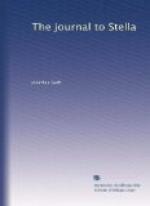5 “Has” (Ms.).
6 A dozen words are erased. The reading is Forster’s, and appears to be correct.
7 The British Ambassadress’s Speech to the French King. The printer was sent to the pillory and fined.
8 The Examiner (vol. iii. No. 35) said that Swift—“a gentleman of the first character for learning, good sense, wit, and more virtues than even they can set off and illustrate”—was not the author of that periodical. “Out of pure regard to justice, I strip myself of all the honour that lucky untruth did this paper.”
9 A purgative electuary.
10 Bargains.
11 Three or four words illegible. Forster reads, “Nite, nite, own MD.”
12 Forster reads, “devil’s brood “; probably the second word is “bawd:” Cf. Letter 60, note 14 and Feb. 18, 1712-13.
13 Several “moving pictures,” mostly brought from Germany, were on view in London at about this time. See Tatler, No. 129, and Gay’s Fables, No. 6.
14 See Letter 6, note 45.
15 “Mr. Charles Grattan, afterwards master of a free school at Enniskillen” (Scott).
16 So given in the Ms. Forster suggests that it is a mistake for “wood.”
17 See Letter 28, note 11.
18 It is probable that this is Pope’s friend, William Cleland, who died in 1741, aged sixty-seven. William Cleland served in Spain under Lord Rivers, but was not a Colonel, though he seems to have been a Major. Afterwards he was a Commissioner of Customs in Scotland and a Commissioner of the Land Tax in England. Colonel Cleland cannot, as Scott suggested (Swift’s Works, iii. 142, xviii. 137-39, xix. 8), have been the son of the Colonel William Cleland, Covenanter and poet, who died in 1689, at the age of twenty-eight. William Cleland allowed his name to be appended to a letter of Pope’s prefixed to the Dunciad, and Pope afterwards described him as “a person of universal learning, and an enlarged conversation; no man had a warmer heart for his friends, or a sincerer attachment to the constitution of his country.” Swift, referring to this letter, wrote to Pope, “Pray tell me whether your Colonel (sic) Cleland be a tall Scots gentleman, walking perpetually in the Mall, and fastening upon everybody he meets, as he has often done upon me?” (Pope’s Works, iv. 48, vii. 214).
19 Henry Grey, Lord Lucas (died 1741), who became twelfth Earl of Kent in 1702, was made Duke of Kent in 1710. He held various offices under George I. and George ii.
20 Forster found, among the MSS. at Narford, the “lie” thus prepared for All Fools’ Day. Richard Noble, an attorney, ran away with a lady who was the wife of John Sayer and daughter of Admiral Nevill; and he killed Sayer on the discovery of the intrigue. The incident was made use of by Hogarth in the fifth scene of “Marriage a la Mode.”
21 See Letter 5, note 3.
22 See Letter 13, note 10.




